Learn how to make a from-scratch apple scrap vinegar. Let’s take a look at the difference between real apple cider vinegar and the apple vinegar you can make at home, as well as a recipe for apple scrap vinegar and my best answers to common questions on making vinegar at home.
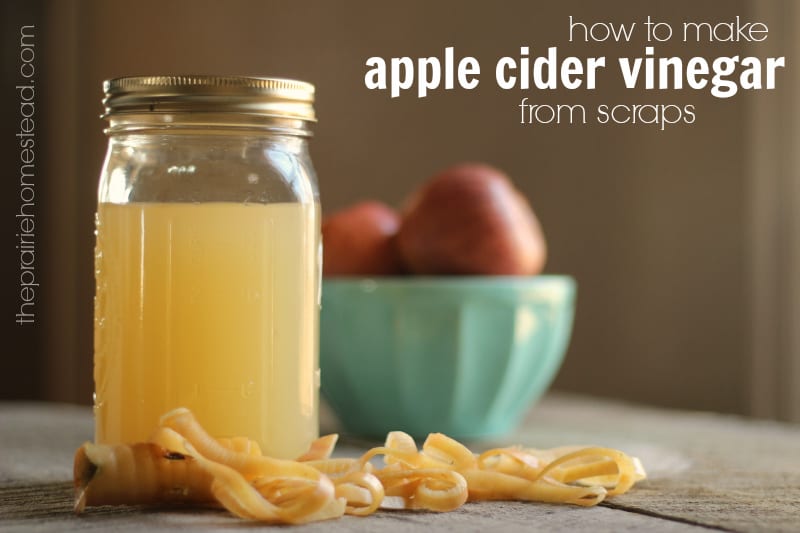
They say there’s no such thing as a free lunch…
But there is homemade apple cider vinegar. And I’m going to venture to say it’s about as close to a free lunch as you’re going to get.
It’s no secret us homesteader folk are complete fanatics about the stuff—we use it for everything from cleaning, to cooking, to animal care and everything in between. The health benefits of raw apple cider vinegar are totally impressive, too. But did you know you can practically make it for FREE?
I know, right?
Mind blown.
There are several more elaborate ways to make apple cider vinegar at home, but today I’m gonna show you how to make it from apple scraps. I especially like this method since it allows me to use the apples for other stuff (like yummy homemade applesauce and canned apple slices) while still making a valuable product from the “waste”. I also like it because it’s crazy easy. And I’m lazy.
Prepared to be impressed. (Want to watch me make it instead of read about? Check out my video below to see how easy this is to make).
Wait, is this a REAL Apple Cider Vinegar or an Apple Scrap Vinegar?!?
Note: this section has been added in March, 2020. After getting many comments from you, my lovely readers, I did a bit more research into this topic. Here’s what I found…
I recently learned that my recipe is actually an apple scrap vinegar. In order to make true apple cider vinegar, you need to first make apple cider, and then change that apple cider into vinegar.
Here’s a great tutorial from the National Center for Home Food Preservation on how to make your own apple cider and at the bottom of the tutorial, they show you how to make apple cider vinegar from it.
My recipe (below) is still a great vinegar to make for your home. It is less acidic than real apple cider vinegar, so do NOT use it for canning (here’s my article on why canning safety is important). It is still an incredibly useful vinegar and has plenty of uses. Plus, I still love that you are using up apple scraps that you would otherwise throw away.
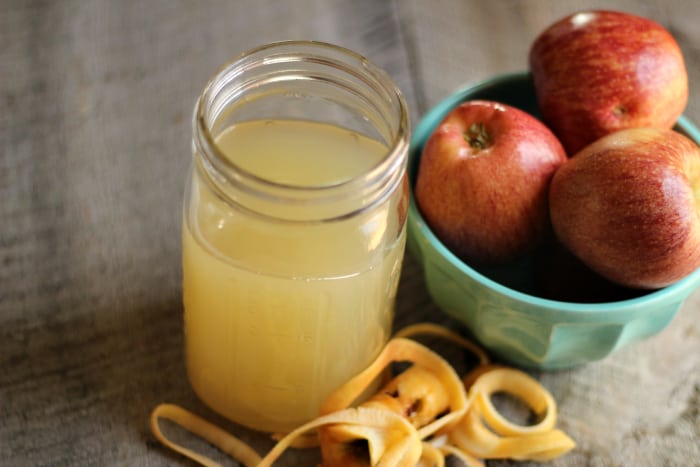
General Information on Making Homemade Apple Scrap Vinegar
Homemade vinegar is the result from fermentation. Fermenting foods at home is a lot of fun (I’m addicted to homemade sauerkraut and I love homemade sourdough bread), but you do need to keep a few things in mind in order to have more successes than failures with home fermenting.
1. Make sure your fermenting jars, bowls, and utensils are clean.
We want to prevent bad bacteria from ruining your batch of homemade apple scrap vinegar. One of the best ways to do this is to start with a clean kitchen and clean supplies. You can use quart or half-gallon jars for this. I love this mixing bowl.
2. Avoid using chlorinated water.
Chlorinated water can kill the naturally occurring microbes that make fermentation possible. If the water from your faucet contains chlorine, either use filtered water instead OR pour your tap water into a bowl or pitcher and leave it out on the counter overnight. By morning, the chlorine will be evaporated enough that it will be safe to use for making this apple vinegar. If you’re in the market for a water filter, this one should to the trick.
3. Do not use metal containers.
Metal reacts badly with fermentations and vinegars and will leave you with a nasty unusable product. To avoid bad tastes and chemicals from leaching into your ferment, try to use glass jars.
4. Don’t ditch the sugar.
The sugar is important for the whole fermentation-turned-into-vinegar process. Don’t skimp on adding the sugar (I use this sugar), since that’s what the bacteria will eat up. You can use honey instead (I love this raw honey), but it will majorly slow the fermentation process down. So if you use honey, expect to add at least a few more weeks to the process.
Uses for Homemade Apple Scrap Vinegar
There are loads of uses for homemade apple scrap vinegar. It can be used for household products and cooking. Just because it’s not an authentic apple cider vinegar doesn’t mean that this apple scrap vinegar isn’t still a great healthy product for the home. It’s also a great frugal option so you don’t just throw away the apple scraps.
Here are some common uses for it:
- Salad dressing recipes
- A substitute for plain vinegar in any recipe
- Use instead of lemon juice in homemade mayonnaise
- Homemade Ketchup
- Homemade Stock or Broth (here’s my favorite basic broth recipe)
- Fruit Fly Traps
- Homemade Natural Cleaning Products (like a DIY shower cleaner)
- Homemade Hair Rinses
- DIY Facial Toner recipes
- Foot Soak recipes
How to Make Apple Cider Vinegar from Scraps
(this post may contain affiliate links)
You will Need:
- Apple peelings or cores
- Sugar (1 tablespoon per one cup of water–I use this one)
- Filtered/Non-Chlorinated Water
- Glass jar (a quart is a great place to start, but you can definitely make larger quantities, too, in which case, use a half gallon jar.)
Instructions:
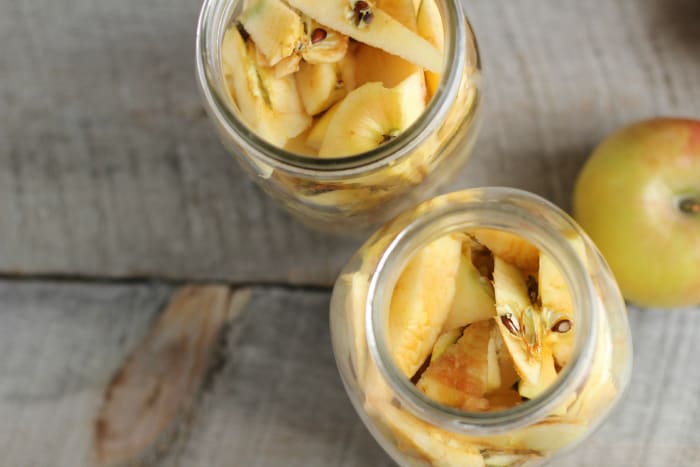
Fill the glass jar ¾ of the way with apple peels and cores.
Stir the sugar into the water until it’s mostly dissolved, and pour over the apple scraps until they are completely covered. (Leave a few inches of room at the top of the jar.)
Cover loosely (I recommend a coffee filter or fabric scrap secured with a rubber band) and set in a warm, dark place for around two weeks.
You can give it a stir every few days, if you like. If any brownish/greyish scum develops on the top, simply skim it off.
Once two weeks has passed, strain the scraps from the liquid.
At this point, my vinegar usually has a pleasantly sweet apple cider smell, but is still missing that lovely tang.
Discard the scraps (or feed them to your chickens!), and set the strained liquid aside for another 2-4 weeks.
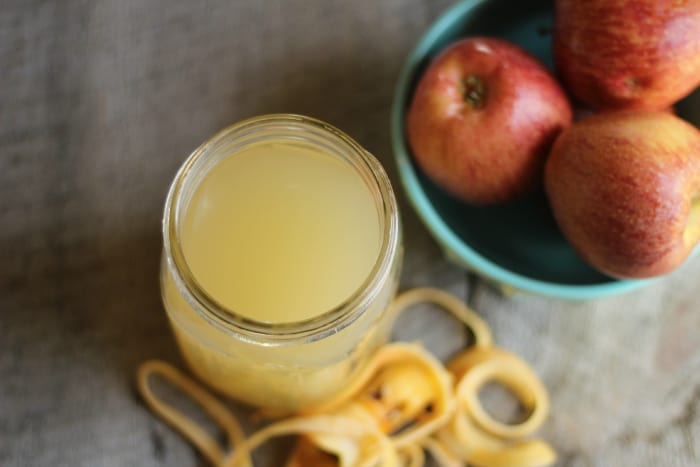
You’ll know your apple cider vinegar is complete once it has that unmistakable vinegary smell and taste. If it’s not quite there yet, simply allow it to sit a while longer.
Once you are happy with the taste of your vinegar, simply cap and store in the fridge as long as you like. It won’t go bad.
If a gelatinous blob develops on the top of your vinegar, congratulations! You have created a vinegar “mother”. This mother can be use to jump-start future vinegar batches. You can remove it and store it separately, but I usually just allow mine to float around in the vinegar as I store it.
Use your homemade vinegar just like you would store-bought vinegar– for cooking, cleaning and everything in between!
About preserving and pickling with homemade vinegar: It’s generally recommended that you do NOT use homemade vinegar for any sort of preservation. In order to ensure the safety of your home canned products, you need a vinegar with a acetic acid level of 5%. Since most of us don’t have a way to check the levels of our homemade vinegar, it’s best just to skip using it for canning or preserving– better safe than sorry!
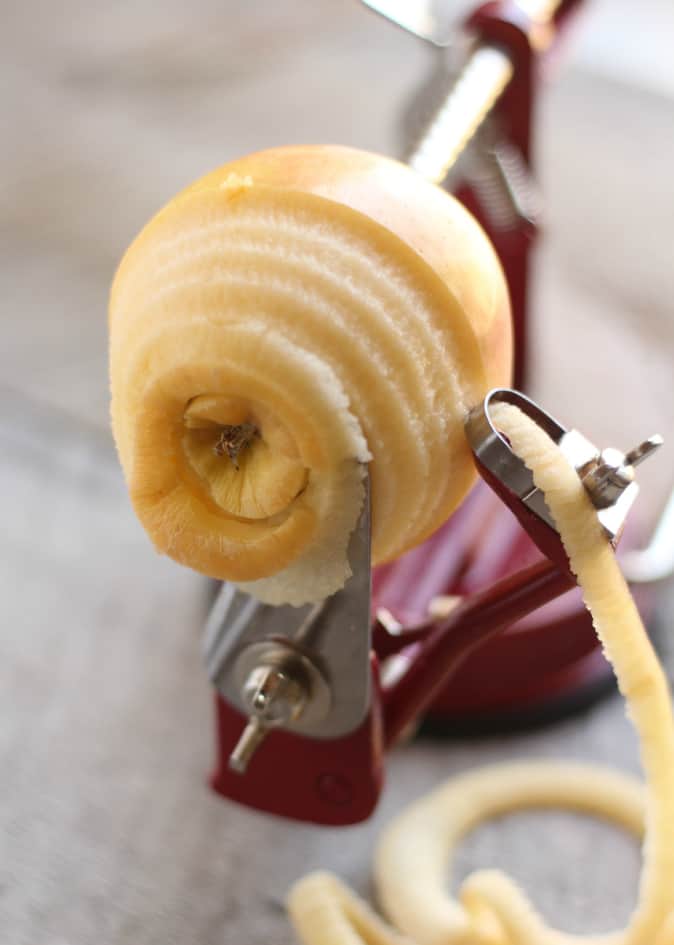
(This is my new favorite way to peel apples– especially if you are needing to process a bunch at a time. It’s brilliant I tell ya, BRILLIANT. Makes this job so much easier!)
Kitchen Notes:
- If your family doesn’t like peels in their homemade applesauce, this is the perfect way to keep them from going to waste.
- It’s perfectly fine to use scraps from slightly bruised or browned apples for your apple scrap vinegar. However avoid using rotten or moldy fruit.
- Don’t have enough apple scraps for a full batch? No problem– just collect your scraps in the freezer until you have enough for a full jar.
- Since we’re using the peels for this recipe, I highly recommend starting with organic apples to avoid any pesticides or chemical residues.
- You can give your homemade vinegar a quick start boost by adding some raw apple cider vinegar to it.
- Your apple scraps might float to the surface. We want them under the liquid, so consider using fermenting weights.
- You could use honey in place of the sugar in this recipe if you really wanted too. However, using honey will slow down the process a bit. Also, keep in mind the beneficial organisms will be eating the sugar throughout the fermentation process, so there’ll be little to no sugar left in the final product. This is my favorite raw honey from a small, family-owned farm based in FL.
- You can make any quantity of vinegar you like—my first batch was in a quart jar, but now I’ve graduated to a gallon jar. *a-hem*
- You can definitely experiment with other fruit scraps too– pears and peaches especially.
- If you’re on a apple kick, here are 100+ other ways to use apples. You’re welcome. 😉
- Don’t want to make your own apple cider vinegar? This is a great option to purchase.
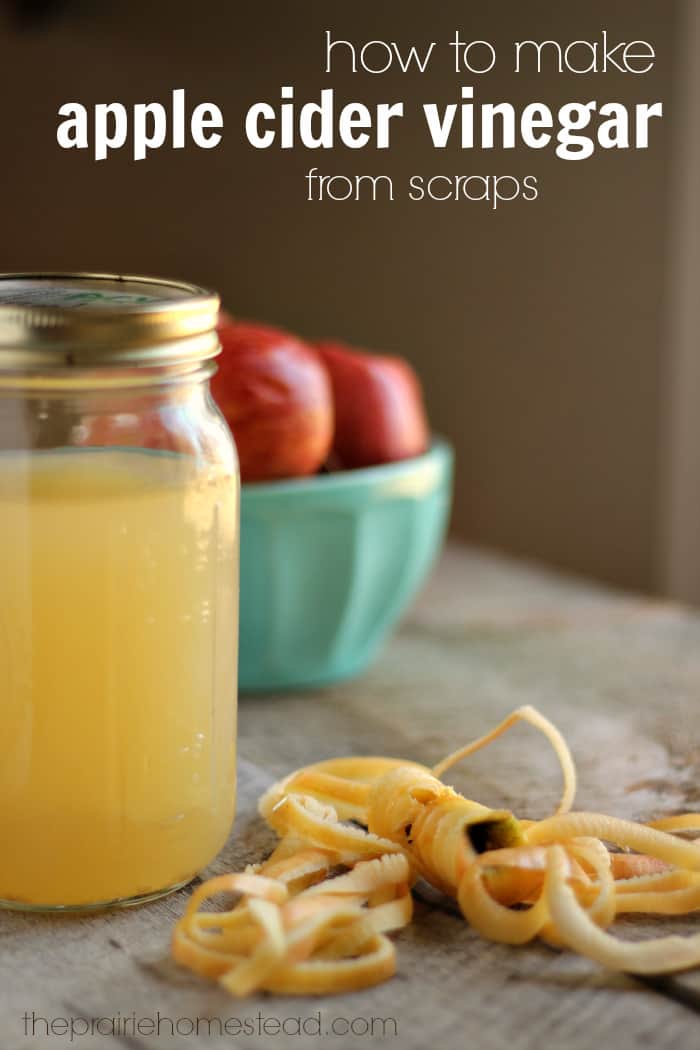
Apple Cider Vinegar from Scraps
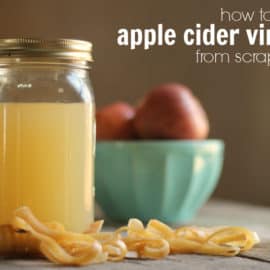
This Apple Scrap Vinegar is a great frugal way to use up apple scraps. This fruity vinegar can be used for many household and cooking recipes and tastes very similar to apple cider vinegar.
- Prep Time: 10 minutes
- Cook Time: 4 weeks
- Total Time: 672 hours 10 minutes
- Category: condiments
- Method: fermenting
- Cuisine: vinegar
Ingredients
- Apple peelings or cores
- Sugar (1 tablespoon per one cup of water used)
- Water
- Glass jar (like this) (a quart is a great place to start, but you can definitely make larger quantities, too.)
Instructions
- Fill the glass jar ¾ of the way with the apple peels and cores.
- Stir the sugar into the water until it’s mostly dissolved, and pour over the apple scraps until they are completely covered. (Leave a few inches of room at the top of the jar.)
- Cover loosely (I recommend a coffee filter or fabric scrap secured with a rubber band) and set in a warm, dark place for around two weeks.
- You can give it a stir every few days, if you like. If any brownish/greyish scum develops on the top, simply skim it off.
- Once two weeks has passed, strain the scraps from the liquid.
- At this point, my vinegar usually has a pleasantly sweet apple cider smell, but is still missing that unmistakable tang.
- Discard the scraps (or feed them to your chickens!), and set the strained liquid aside for another 2-4 weeks.
- You’ll know your apple cider vinegar is complete once it has that unmistakable vinegary smell and taste. If it’s not quite there yet, simply allow it to sit a while longer.
- Once you are happy with the taste of your vinegar, simply cap and store it as long as you like. It won’t go bad.
- If a gelatinous blob develops on the top of your vinegar, congratulations! You have created a vinegar “mother”. This mother can be use to jump-start future vinegar batches. You can remove it and store it separately, but I usually just allow mine to float around in the vinegar as I store it.
- Use your homemade vinegar just like you would storebought vinegar– for cooking, cleaning and everything in between!
Notes
- If your family doesn’t like peels in their homemade applesauce, this is the perfect way to keep them from going to waste.
- It’s perfectly fine to use scraps from slightly bruised or browned apples for your apple scrap vinegar. However avoid using rotten or moldy fruit.
- Don’t have enough apple scraps for a full batch? No problem– just collect your scraps in the freezer until you have enough for a full jar.
- Since we’re using the peels for this recipe, I highly recommend starting with organic apples to avoid any pesticides or chemical residues.
- You can give your homemade vinegar a quick start boost by adding some raw apple cider vinegar to it.
- Your apple scraps might float to the surface. We want them under the liquid, so consider using fermenting weights.
- You could use honey in place of the sugar in this recipe if you really wanted too. However, using honey will slow down the process a bit. Also, keep in mind the beneficial organisms will be eating the sugar throughout the fermentation process, so there’ll be little to no sugar left in the final product.
- You can make any quantity of vinegar you like—my first batch was in a quart jar, but now I’ve graduated to a gallon jar.
- You can definitely experiment with other fruit scraps too– pears and peaches especially.
More Heritage Kitchen Tips:
- Canning Apple Slices Recipe (and then use the scraps for this homemade apple vinegar recipe!)
- Heritage Cooking Crash Course (learn how to cook old-fashioned foods quickly and easily)
- How to Use a Fermenting Crock
- A Guide to Quick Pickled Vegetables

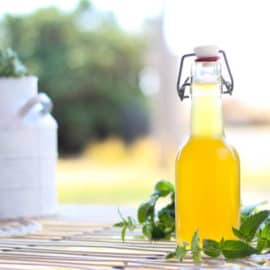

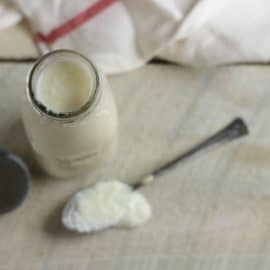
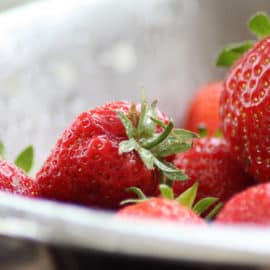
What a great way to use the scraps. I wish I had found this a few months ago.. we purchased almost 50 lbs of “seconds” from an orchard with the hopes of giving them to our pigs.They turned their little snouts up and walked the other way. I ended up looking at them for about a week and a half trying to decide what to do with them. They ended up in the compost bin.
Oh my… picky pigs! 🙂
Never would have even thought possible. You are a genius. I will need to try next fall after the apple harvest!
Jill, thanks for a great idea! Such a good way to use up something we normally throw away! One thing I was wondering about: does one need to worry about using the seeds because of the arsenic present in them? Norma
Wow! That seems easy enough! Thanks for sharing.
Lori
Wow! Thank you! When we set it aside for another two weeks after straining should it be covered? Or left uncovered like before? I’m starting mine today!
Yes– definitely cover it. 🙂
We can spiced apple rings in the fall and have LOTS of scraps left over…what a great way to use up the whole apple! Thank you for posting this!
Such a great post!! I almost made apple cider vinegar last fall, but ended up avoiding it due to one little problem! We don’t spray our trees with any chemicals, and every year our apples are covered with sooty blotch and/or fly speck (both a type of fungus). Does anyone know if those would effect making apple cider vinegar with the peels?
This is one of my favorite posts! Raw apple cider is very expensive here and I would love to use more of it but wasn’t sure my checkbook could handle it. Two of my children are VERY picky eaters and refuse to eat apple peels, so this is a win, win for me. Thank you for inspiring so many changes in my life!
You are very welcome Kati!
Such weird timing! I was just reading Farmer Boy last night and they talked about using apple cores to make vinegar. I mentioned it to my husband and we talked about lost arts and using everything… then I see this today! I think it’s a sign that I have to try it 🙂
I love timing like that!
I have a friend that makes homemade apple cider vinegar. She loves it.
I’ll definitely do this with all of our apple peels and cores. Too bad I have to wait for the apples to grow.
I’ve been making tons of baby applesauce lately – now I know what to do with all my scraps!
Once you have a “mother”, how do you keep it? In the refrigerator as well? Will it die if not “fed”?
Great post, thank you!
You’ll need to keep it floating in a batch of vinegar to keep it alive.
How would I use the ‘mother’?
I love making vinegar with my apple scraps! There is such a great feeling of accomplishment to have made some applesauce or dried apples from scratch, used the peels to make vinegar, then use the peels AGAIN to make awesome compost to grow veggies with. Awesome circle of life if you ask me. 🙂
I couldn’t agree more! Waste not, want not. 🙂
Thought I’d pop over to see what my friend has been up to. How fun! The last time I made apple cider vinegar was by accident, lol. I had pressed apples for raw apple juice, but forgot a jar in the back of my fridge. Several months later I discovered it and took a whiff to see if it was still good. It had begun to ferment and was at the hard cider stage. I left it on the counter for a few more weeks and eventually it turned to apple cider vinegar. 🙂 I love these kinds of experiments!
Gotta love accidents like that! 🙂
I just made a lot of apple cider with some summer apples and thought I’d make some vinegar with some of it. Any reason why this wouldn’t be better than the scraps and chunks and sugar method?
Hi Jill! Thanks so much for sharing this great recipe! Quick question – is the sugar necessary for anything besides taste? We’re a very low sugar family, and if it’s just for taste, I’d leave it out, but wondering if it’s needed for fermenting. Thanks so much!
The sugar helps the fermenting process to be a bit faster. The bacteria feasts on it. However, you can omit it if you like. 🙂
Can i use this applecider vinegar for weight loss. I have lots of apples but yuk they not tasty enough to eat raw. Something wrong with the tree i suppose.
Sounds like you might have a sour apple tree. 🙂
I was also wondering if this would be good to take a tablespoon before every meal if you are trying to lose weight, like some people do with store bought vinegar?
It definitely couldn’t hurt!
WOW!!! Would never have thought it was possible to make vinegar.
I’m so excited about this post! We went apple picking last year and had so many leftover cores from our applesauce. I tried making apple juice from them but it didn’t pan out as I had expected. I use so much vinegar year round so this will definitely be bookmarked! Thank you!
Enjoy Shenna!
Jill, I am sharing all of your “homemades” with my friends that love this kinda stuff! I was wondering if the vinegar has to be kept in the fridge once the fermentation process is done?
Also, a quick comment to your comment about people who live in Texas… I am sorry that you are not able to work in your garden yet… I’ve lived here all my life but now, aside from the sultry summers, I am starting to love it here for the simple fact of being able to “keep” something growing year around… 2015 is starting my second year with a real garden!
Yes– it’ll store in the fridge for a loooong time once it’s done. 🙂 And it’s awesome you can grow all year!
I use the peel in making my apple sauce. I just throw the apples in the crockpot, then when they are mushy, I use my ricer to removed the peels. Can I use these cooked peels to make the cider vinegar? Thank you!
They’ll need to be raw to work in the vinegar. 🙂
Ooh! I just made some dehydrated apple chips for the kids (They love apple chips), this is a perfect way to deal with the scraps! I have a friend who uses organic apple cider for everything, and I’m already buying organic apples for the apple chips (I just bought trees to grow my own, but they aren’t producing yet) Two birds stoned at once haha!
So funny! I made apple chips from the apples I peeled for this post too. 🙂
What about fruit flies?
This has been on my bucket list…since we have 4 apple trees. I do everything with them, but I’ve yet to make vinegar. It will be fall (apple season) before I get around to this. Thanks for the nudge!
I’m totally jealous of your apple trees!!
Wow! Where did you learn this? You are the best…. I use acv constantly & had no idea it was this easy to make.
Will make some this week. Braggs is gonna have a decline in sales!!
You’re gonna love it!
Thanks for the apple cider vinegar post. I’ve stopped using apple peels because so many of them are waxed. And I don’t want to eat that!
Good point– yes, it’s best if you can use organic/safe apples. 🙂
When the mother falls to the bottom of the jar, you know your vinegar is done. I made 10 gallons last summer. I got bragging rights.
Way to go Janie! You definitely have bragging rights!
Did you guys know that apple cider vinegar is GREAT for treating acne? You’d be surprised on how effectively it works!
Very cool!
I am new of homesteading but have a wimpy apple tree in my yard. We don’t really treat it with anything but this year I plan to look at it a little more closely to see if I can do anything organically to it to help it along. In the past the apples have been quite scabby/wormy and sour. Would this effect the vinegar at all or have I found the perfect use for my apples?
Yeah, I would avoid using the scabby/wormy apples in your vinegar. 😉
We are wondering about how to use the vinegar scoby. We already are using our wonderful scrap apple cider vinegar and have the scoby’s. Do we put the scoby on top of the apple peelings and scraps, or do we wait until we strain the scrap out & then add the scoby?
Thanks , Renate andDJ
We have three apple trees in our back yard and I am tired of making applesauce. I plan on freezing a bunch for future holiday baking but am so glad to find a way to use the peels and cores other than to make pectin with. Thank you so much for this post I can’t wait to try this out!
I need to know the same thing as Renate above. I have a mother of vinegar, and want to make more vinegar. I do not have apple cider available to me, so would like to go with the scraps again. How to proceed?
Thanks!
I love your website an recipes. Its a hugh help in making changes in multiple areas of our current lifestyle. Ok so I have a question. Is it possible to leave it on the counter with scraps for too long? With school starting and all I totally forgot when I started the process. Its been on the counter long enough for the scraps to start dropping to the bottom. Have I ruined my vinegar?
If it still smells OK and isn’t moldy, you should be fine.
Love this site,I have a question. Do I have to store vinegar in fridge? My space there is limited.
Do you know if you can use pear cores/peels? I am about to make pear butter but would love to make vinegar with the scraps.
Yes, pear scraps should work too!
How can I use the mother to make more vinager, do I need to put more apples?